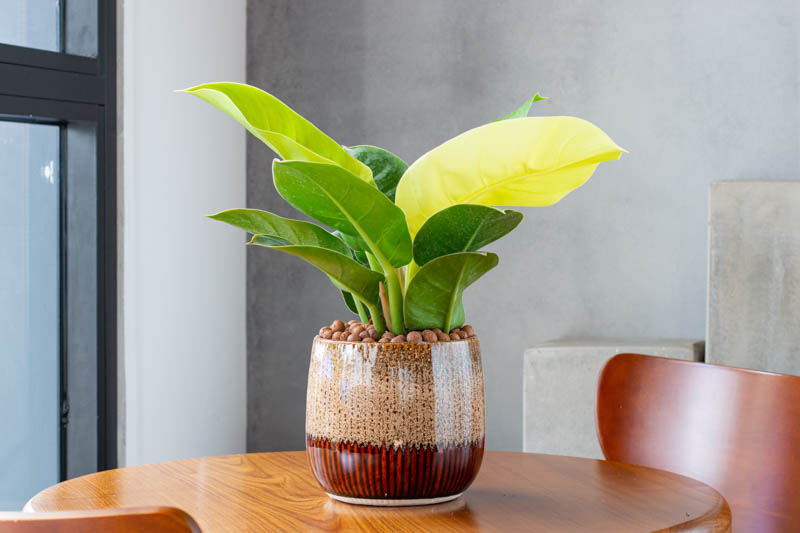In the world of houseplants, some plants are admired for their bold structure, others for their lush, trailing vines. But then there’s the Philodendron Moonlight—a compact, tropical gem that glows with neon green brilliance, lighting up any corner it graces.
If you’re looking to add a splash of color without sacrificing ease of care, this low-maintenance, high-impact plant might just be the one. In this guide, we’ll explore what makes the Philodendron Moonlight so special, how to care for it, and tips to help it thrive year-round.

What Is Philodendron Moonlight?
Philodendron Moonlight is a hybrid variety of philodendron that’s beloved for its chartreuse to lime-green foliage. Unlike many philodendrons that climb or trail, Moonlight has a self-heading, bushy growth habit—making it ideal for tabletops, desks, and tight indoor spaces.
New leaves emerge in a bright lemon-lime tone and slowly mature into a deeper green. The contrast between new and old growth gives it a constantly shifting, eye-catching appearance.
Native to tropical regions of South America, the Moonlight belongs to the Araceae family but is cultivated globally as an ornamental plant due to its vibrant color and compact form.
Why Choose Philodendron Moonlight?
Here’s why it’s one of the top picks for both beginners and collectors:
- Vibrant foliage that adds a pop of color without flowers
- Non-vining habit, so it won’t overtake small spaces
- Low maintenance—perfect for busy or forgetful plant parents
- Air-purifying properties like many other philodendrons
- Pest-resistant when grown in ideal indoor conditions
This plant brings tropical warmth into modern interiors, pairing well with minimalist decor, earthy tones, or maximalist green spaces.
Light Requirements
Philodendron Moonlight thrives in bright, indirect light but is also tolerant of moderate light conditions. Avoid direct sunlight, which can scorch its leaves, especially the tender neon ones.
- Best spot: Near an east-facing window or a few feet away from a bright south or west-facing window.
- Low light: It will survive, but new growth may be slower, and the bright colors may fade.
If you notice leggy growth or dull leaves, that’s a sign your Moonlight needs more light.
Watering Guide
This plant prefers its soil slightly moist but never soggy. Overwatering is the most common cause of decline in philodendrons.
Watering tips:
- Allow the top inch or two of soil to dry out between waterings.
- Water thoroughly, then let excess drain completely.
- Cut back in winter when the plant’s growth naturally slows.
Signs of overwatering: yellowing lower leaves, mushy stems, fungus gnats.
Signs of underwatering: curled leaves, crispy edges, drooping foliage.
Soil and Potting
Use a well-draining, chunky potting mix that retains moisture but doesn’t stay wet for long.
Ideal mix:
- 50% high-quality potting soil
- 25% orchid bark
- 15% perlite or pumice
- 10% coco coir or peat
Choose a pot with drainage holes. Terracotta pots work well because they allow moisture to evaporate, reducing the risk of root rot.
Temperature and Humidity
Philodendron Moonlight is a tropical plant, so it enjoys warmth and humidity.
- Ideal temp: 65°F–80°F (18°C–27°C)
- Avoid: Drafts, heaters, or sudden temperature drops
- Humidity: 50% or higher is best, but it can tolerate standard indoor humidity
To boost humidity:
- Use a pebble tray with water
- Place near a humidifier
- Group with other plants
Crispy edges on leaves may indicate the air is too dry.
Fertilizing Schedule
Feed your Moonlight monthly during spring and summer with a balanced liquid houseplant fertilizer diluted to half strength.
Skip fertilizing during fall and winter unless the plant shows signs of active growth. Overfertilization can lead to salt buildup and leaf burn.
Pruning and Maintenance
Moonlight grows in a tight rosette form and doesn’t need regular pruning. However, occasional grooming keeps it looking its best.
- Remove yellow or dead leaves at the base
- Wipe down leaves monthly to remove dust and improve photosynthesis
- Rotate the plant every few weeks to encourage even growth
Propagation
While the Moonlight isn’t as easy to propagate as vining philodendrons, it can be propagated via division.
To propagate:
- Gently remove the plant from its pot during repotting.
- Look for natural offshoots or clumps with separate root systems.
- Use a clean knife to divide and repot each section in fresh soil.
Let it acclimate in a warm, humid space after division.
Is Philodendron Moonlight Pet Safe?
Sadly, no. Like other philodendrons, Moonlight contains calcium oxalate crystals, which can irritate the mouth and digestive system if ingested by pets or children.
Keep it out of reach of cats, dogs, and little hands.
Common Problems and Solutions
| Problem | Cause | Solution |
|---|---|---|
| Yellowing lower leaves | Overwatering or old leaves | Adjust watering or remove aging foliage |
| Brown tips or edges | Low humidity or underwatering | Mist plant or use a humidifier |
| Pale or faded new leaves | Insufficient light | Move closer to bright, indirect light |
| Drooping plant | Thirsty or root-bound | Check moisture level or repot |
Final Thoughts
Philodendron Moonlight is the perfect combination of bold color and easygoing nature. Its vibrant neon leaves bring life to any space without demanding much in return. Whether you’re starting your houseplant journey or looking to brighten your collection, this tropical hybrid is a low-fuss, high-reward addition.
With the right care, your Moonlight will reward you with lush growth and glowing new leaves that look like they’re lit from within.

Leave a Reply